 Navigation
Navigation

Polkadot Was the Blockchain Unicorn of 2020
|
|
Polkadot Was the Blockchain Unicorn of 2020
To say 2020 was a breakout year for Polkadot would be an understatement. Over the past 12 months, Gavin Wood’s interoperable blockchain and parachain ecosystem finally started to deliver on the bold promise outlined in its 2017 ICO, when the much vaunted project raised a staggering $145 million. Indeed, there were so many milestones hit this year, it’s difficult to know where to begin. In his year-end review, published on December 30, Gavin Wood struggled to cram in all of the network’s highlights – though he gave it his best shot.
Hello, Genesis Block
“Polkadot CC1 is freshly born; beginning its “life” at 17:36:21, Zug time,” wrote Gavin Wood on May 26, 2020. For the Ethereum co-founder, it looked like the culmination of a dream that began in 2016, and for the investors and commentators who shared the developer’s enthusiasm, it was time to break open the champagne. Launched under a Proof-of-Authority (PoA) consensus algorithm controlled by the Web3 Foundation, the third-generation blockchain was now in the wild and on track to make good on its vision of heightened security, scalability and innovation.
In truth, the genesis block was Fake News – as Wood himself acknowledged. “CC1 is our first candidate for the Polkadot mainnet… we have not exactly ‘launched’ Polkadot.” The real action came with the emergence of parachains bolted to Polkadot, and with the entry of the network’s native DOT token into the top ten by market cap following its much publicized redenomination. (The latter followed a referendum that saw the token’s circulating supply inflated by a factor of 100.)
In August, DOT’s trade volumes topped out at $1.4 billion, eclipsing Chainlink’s and resulting in a slew of breathless op-eds. Polkadot had officially arrived.
Parachains, Projects and Partnerships
An interoperable blockchain network that scales by distributing transactions across parallel “shards” known as parachains, Polkadot was always going to get tongues wagging. And so it proved in 2020. Much of the discussion centered on the parachains themselves, with many such shards appearing on the Rococo testnet following its August launch. Rococo enables projects to verify their technology before deploying for real on Kusama, Polkadot’s so-called canary network, and later to Polkadot itself.
Parachains connect to the main Polkadot Relay Chain, where transactions are settled. This year, those attracting attention included Acala, a decentralized stablecoin and liquid staking platform, and Moonbeam, an Ethereum-compatible smart contract parachain. According to a blog post published just before Christmas, parachain registration will be opened up to the community early in the New Year – as many as 100 could eventually be connected to the main network.
The number of projects that have gravitated to Polkadot this year, meanwhile, has been staggering; there are over 320 at the time of writing, comprising cross-chain bridge protocols, crypto wallets, stablecoins, DEXs, staking services and everything in between. According to a report by Outlier Ventures, the Polkadot ecosystem enjoyed the largest spike in developer activity of all blockchains at the midpoint of 2020, with the community growing by 44%.
Although Polkadot announced in February that it would integrate with data oracle network Chainlink, becoming the first ecosystem outside of Ethereum to do so, the bond was further cemented this month with the launch of a decentralized finance alliance. Going forward, Chainlink will be heavily involved in promoting Polkadot’s burgeoning ecosystem of decentralized finance (defi) applications. Not a bad ally to have on-side.
Defi Comes to Polkadot
Decentralized finance was the runaway success story of 2020, hitting $1 billion in value locked in February then soaring beyond $13 billion come November. Between Uniswap’s automated market maker, various liquidity mining schemes, and innumerable lending, saving and staking protocols, defi caught everyone by surprise this year and stole the spotlight from Bitcoin – until the latter mooned past 20k, anyway.
Though defi currently lives on Ethereum, Polkadot’s sophisticated defi stack is growing at an astonishing rate. Projects like Polkastarter, a DEX and launchpad that enables users to buy tokens using ETH, and Equilibrium, a cross-chain money market comprising pooled lending with synthetic asset generation/trading, are helping the blockchain make a play for Ethereum’s crown.
The question of whether Polkadot can succeed ETH as the dominant defi network attracted on-off debate all year, not least from Crypto Zombie, who pondered the notion with his 149K YouTube subscribers.
Polkadot has an inherent advantage over its rival, since devs can deploy their infrastructure atop defi chains within its ecosystem rather than forge their own native parachains. Of course, defi built on Ethereum and Bitcoin can also communicate within the Polkadot ecosystem using bridges. Moreover, a new Polkadot-based wrapped version of Bitcoin (PolkaBTC) enables users to interact with defi using the world’s preferred cryptocurrency.
All of which is to say that Polkadot is one of several projects for whom the future looks impossibly bright (DOT has gained 62% over the past month). While much will depend upon the success of disparate parachains and projects spreading out from its Relay Chain, not to mention the wider decentralized finance movement, Polkadot has laid the foundations for another strong year in 2021.





